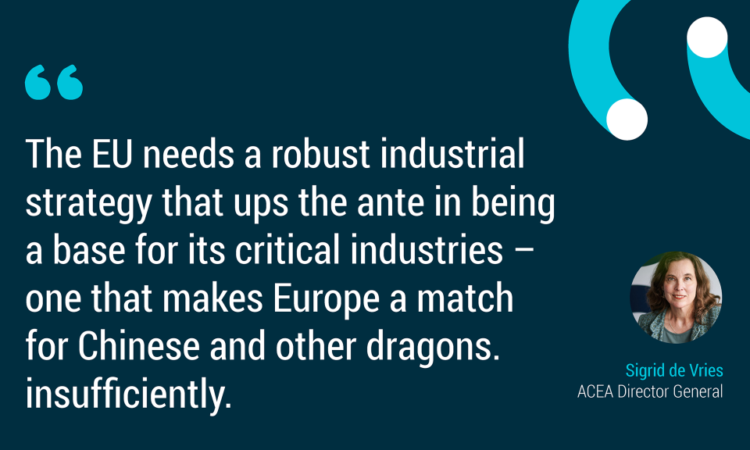
Message from ACEA Director General – August 2023
Europe lacks a robust and coherent approach to the increasingly tough competition from abroad, supported by governments that marry their green and digital transitions with national resilience in a combative and decisive way. In particular, China has its gaze set on the European market, with the potential to fundamentally change the face of Europe’s industries as we know it.
This June, ACEA data revealed that EU sales of battery-electric cars outpaced diesel for the first time. These positive figures in the fight against climate change also expose another trend: Chinese brands and Chinese-made vehicles are making rapid inroads into the European electric vehicle (EV) market.
Propped up by public money and government intent, it is no secret that China’s auto industry now mounts a challenge to the auto industry in Europe and beyond – and it appears China’s strategic decision to invest early and along the entire value chain is paying dividends.
Unlike in Europe, China has adopted a holistic approach to industrial policy, looking at the entire value chain for what it considers strategic industries. Applied to the auto industry, a sector with a broad domestic economic impact, this means a strategy from mining, refining, and manufacturing to charging networks, cheap energy, purchase incentives, and recycling across the whole life cycle – a coordinated effort from the outset combined with agility in every subsequent step on the way. Today, China accounts for 75% of global battery production capacity and has a near monopoly on critical raw material supplies. In 2022, in just one year, the country installed 800,000 EV charging points – almost as much as the total installed elsewhere, globally, since investments in charging infrastructure started.
Contrary to their counterparts in China and the US, who recently launched the game-changing Inflation Reduction Act (IRA), EU legislators have opted for a more piecemeal approach, often setting targets first and dealing with essential framework conditions for implementation later or insufficiently. This is the case with the Alternative Fuels Infrastructure Regulation (AFIR), which came late and fell short of minimum needs. The recently adopted EU Batteries Regulation also still leaves details unclear, adding cost and complexity to the battery supply chain in Europe. The lack of synchronisation constrains the flourishing of the EV market at a moment when scaling up is crucial to meet legal objectives. Policy makers should also ensure secure access to affordable energy.
Due to the external pressure, the EU is now upping its game across different value chain steps, ranging from the Critical Raw Materials Act to the Net-Zero Industry Act. Yet, while these initiatives certainly have merit, they remain piecemeal and largely expressions of aspiration. A truly strategic policy must address challenges more coherently to match the sizable efforts made in other regions.
Europe must accelerate the build-up of local capacity and secure existing ties and new partnerships with third countries. The recent Chinese export restrictions on germanium and gallium, two materials vital for microchips, provide a flavour of what could come if the EU does not find a way to become less reliant on others and keep trade relations as open, fair, and supportive as possible – including those with China.
Finding a balanced approach is important as the opening of the Chinese market – restrictive as it might still be in major aspects – has reaped significant rewards for many European manufacturers and is set to continue to do so despite fiercer competition from homegrown brands.
China is the biggest vehicle market in the world and a serious production and innovation hub for components and vehicles. Chinese vehicle manufacturing has reached a formidable maturity level, and technology now travels in both directions. This maturity, combined with a drive to expand beyond an increasingly crowded market at home and to secure further growth, explains the move to seek market share in Europe, with the logical next step being to establish manufacturing overseas.
True enough, EV exports to the EU also include vehicles built by European and other international brands in China. Furthermore, EV sales only amount to around 13% of the EU market as electrification is booming but is also still in its early days. Moreover, European brands have a long-held relationship with their customers across all corners of the globe and a solid legacy to build on as leading innovators and competitors worldwide – their increasingly strong and wide-ranging EV offering is a testament to this.
But what is at stake is the competitiveness of Europe as a natural home for manufacturing industries. The European auto industry is absorbing the transition costs of the combustion engine phaseout, investing significant resources into the build-up of EV and hydrogen solutions while operating within a framework of stringent boundary conditions, high inflation, and a saturated market. China’s comparative advantage and cost-competitive imports could chip away at European auto makers’ domestic market share, ultimately impacting local activity.
A strategic industry can only thrive in a competitive framework. Europe’s competitiveness has traditionally suffered from higher energy costs, a heavier administrative burden, and the fragmentation inherent to a 27-member state construct. It has now been further eroded by other continents’ massive efforts, risking manufacturing and employment in Europe.
Therefore, we welcome that the murmurings within the corridors of Brussels are becoming louder: the EU needs a robust industrial strategy that ups the ante in being a base for its critical industries. A strategy that steers clear of protectionism and naivety, broadening perspective beyond its internal gaze and creating conditions for sustainable economic activity – one that makes Europe a match for Chinese and other dragons.
Sigrid de Vries
Director General of ACEA
The EU needs a robust industrial strategy that ups the ante in being a base for its critical industries – one that makes Europe a match for Chinese and other dragons.






